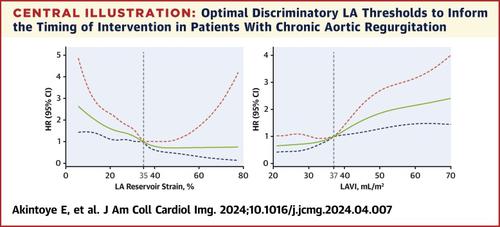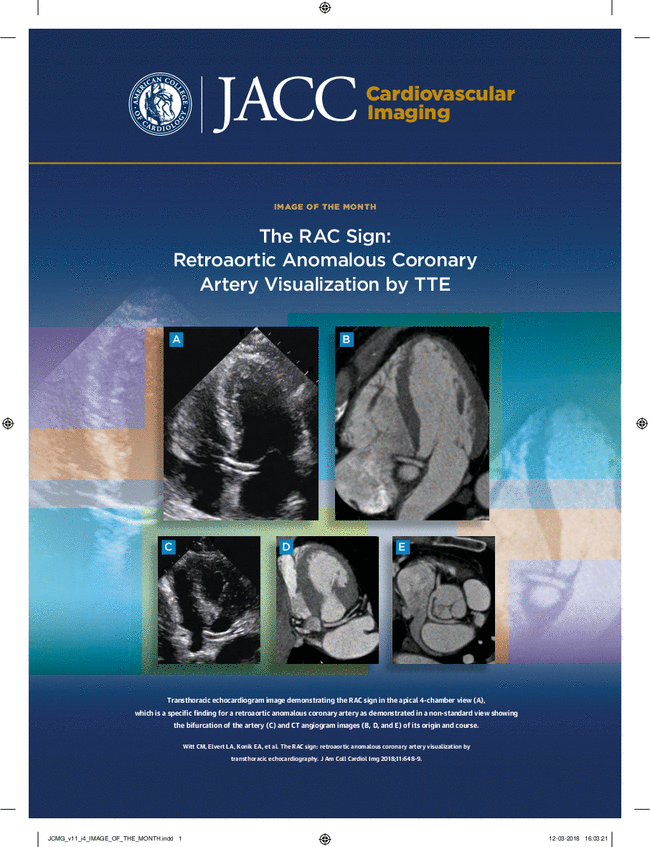Longitudinal Assessment of Left Atrial Remodeling in Patients With Chronic Severe Aortic Regurgitation
IF 12.8
1区 医学
Q1 CARDIAC & CARDIOVASCULAR SYSTEMS
引用次数: 0
Abstract
Background
There are significant sex and age differences in left ventricular (LV) remodeling that may lead to disparity in outcomes when used to inform the timing of aortic regurgitation (AR) intervention.
Objectives
The aim of this study was to examine whether left atrial (LA) parameters might represent better criteria than LV parameters to inform the timing of AR intervention.
Methods
Using data on patients with moderate to severe or severe AR with serial echocardiography (2010-2016), the longitudinal trends in left atrial volume index (LAVI) and left atrial reservoir strain (LAr) were evaluated by sex and age. The incremental utility of these parameters in predicting adverse events over LV parameters was also determined.
Results
In 525 patients (25.7% women) with 1,687 echocardiograms over a median follow-up period of 2.0 years (Q1-Q3: 1.0-3.6 years), there was significant increase in LAVI (1.0 mL/m2 per year [95% CI: 0.76-1.2 mL/m2 per year]) and decrease in LAr (−1.3% per year [95% CI: −1.6% to −0.92%]), without a significant interaction by sex or age category (P for interaction ≥ 0.17). In addition, both LAVI and LAr were significant predictors of adverse events independent of LV parameters. The optimal discriminatory thresholds were 37 mL/m2 for LAVI and 35% for LAr. These thresholds were similar across categories of sex and age. Within the relatively short-term follow-up, surgery was associated with survival benefit among patients with LAVI ≥37 mL/m2 (HR: 0.33 [95% CI: 0.15-0.72]; P = 0.006) but was not statistically significant among patients with LAVI <37 mL/m2 (HR: 0.46 [95% CI: 0.18-1.17]; P = 0.09). Similarly, surgery was associated with survival for the subgroup with LAr ≤35% but not among those with LAr >35%.
Conclusions
Unlike LV remodeling, LA remodeling demonstrates a similar rate of progression between categories of sex and age among patients with AR. In addition, LA parameters provide incremental prognostic value over LV parameters.

对慢性严重主动脉瓣反流患者左心房重塑的纵向评估
背景:左心室(LV)重塑存在明显的性别和年龄差异,如果将其作为主动脉瓣反流(AR)干预时机的依据,可能会导致结果的差异:本研究旨在探讨左心房(LA)参数是否比左心室参数更适合作为判断主动脉瓣反流介入时机的标准:利用连续超声心动图检查的中重度或重度AR患者的数据(2010-2016年),按性别和年龄评估了左心房容积指数(LAVI)和左心房储应变(LAr)的纵向趋势。此外,还确定了这些参数在预测不良事件方面比左心室参数的增量效用:在中位随访期为 2.0 年(Q1-Q3:1.0-3.6 年)、接受了 1,687 次超声心动图检查的 525 名患者(25.7% 为女性)中,LAVI 显著增加(每年 1.0 mL/m2 [95% CI:每年 0.76-1.2 mL/m2]),LAr 显著下降(每年-1.3% [95% CI:-1.6% 至-0.92%]),但与性别或年龄类别无显著交互作用(交互作用的 P ≥0.17)。此外,独立于左心室参数,LAVI 和 LAr 都是不良事件的重要预测因子。LAVI 和 LAr 的最佳判别阈值分别为 37 mL/m2 和 35%。这些阈值在不同性别和年龄的人群中相似。在相对较短的随访时间内,LAVI ≥37 mL/m2 患者的手术与生存获益相关(HR:0.33 [95% CI:0.15-0.72];P = 0.006),但 LAVI 2 患者的手术与生存获益无统计学意义(HR:0.46 [95% CI:0.18-1.17];P = 0.09)。同样,在LAr≤35%的亚组中,手术与生存率相关,但在LAr>35%的亚组中,手术与生存率无关:结论:与左心室重塑不同,LA重塑在不同性别和年龄的AR患者中表现出相似的进展速度。此外,LA参数比左心室参数更具预后价值。
本文章由计算机程序翻译,如有差异,请以英文原文为准。
求助全文
约1分钟内获得全文
求助全文
来源期刊

JACC. Cardiovascular imaging
CARDIAC & CARDIOVASCULAR SYSTEMS-RADIOLOGY, NUCLEAR MEDICINE & MEDICAL IMAGING
CiteScore
24.90
自引率
5.70%
发文量
330
审稿时长
4-8 weeks
期刊介绍:
JACC: Cardiovascular Imaging, part of the prestigious Journal of the American College of Cardiology (JACC) family, offers readers a comprehensive perspective on all aspects of cardiovascular imaging. This specialist journal covers original clinical research on both non-invasive and invasive imaging techniques, including echocardiography, CT, CMR, nuclear, optical imaging, and cine-angiography.
JACC. Cardiovascular imaging highlights advances in basic science and molecular imaging that are expected to significantly impact clinical practice in the next decade. This influence encompasses improvements in diagnostic performance, enhanced understanding of the pathogenetic basis of diseases, and advancements in therapy.
In addition to cutting-edge research,the content of JACC: Cardiovascular Imaging emphasizes practical aspects for the practicing cardiologist, including advocacy and practice management.The journal also features state-of-the-art reviews, ensuring a well-rounded and insightful resource for professionals in the field of cardiovascular imaging.
 求助内容:
求助内容: 应助结果提醒方式:
应助结果提醒方式:


